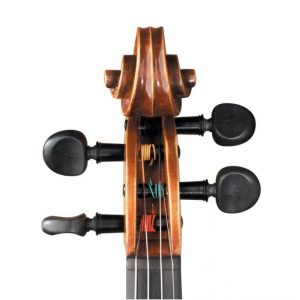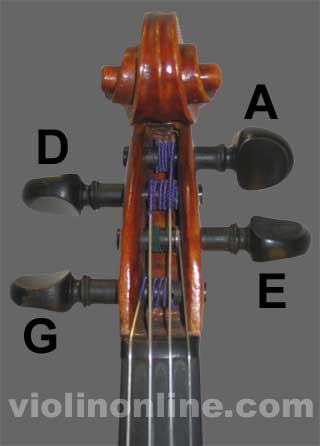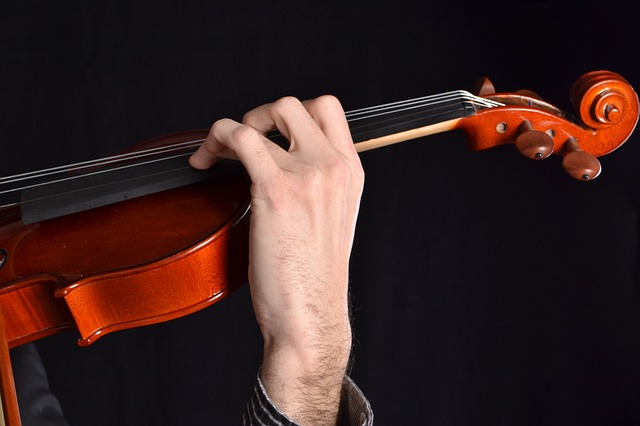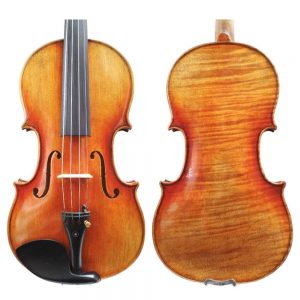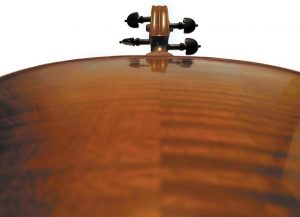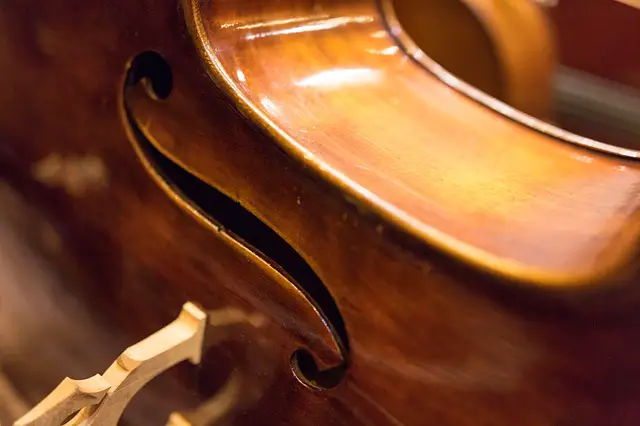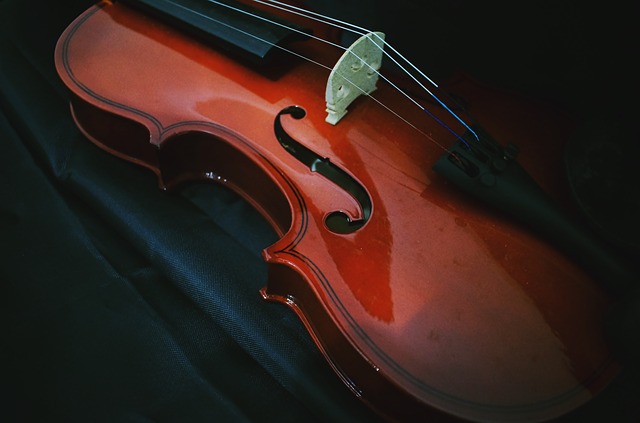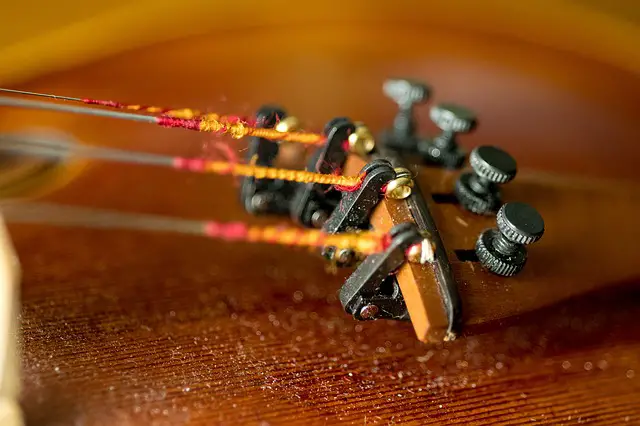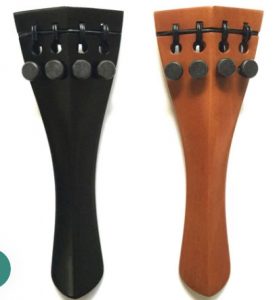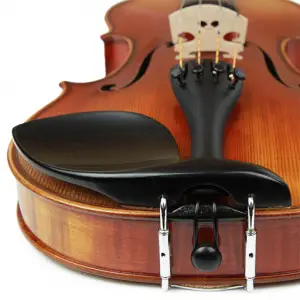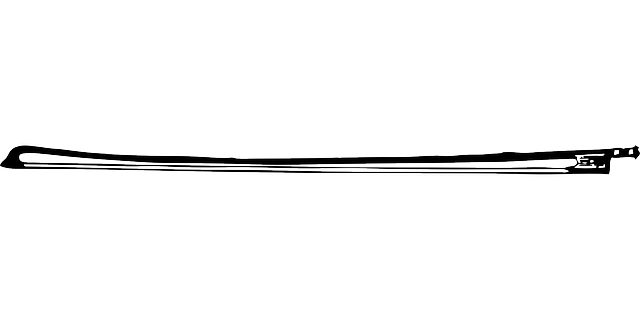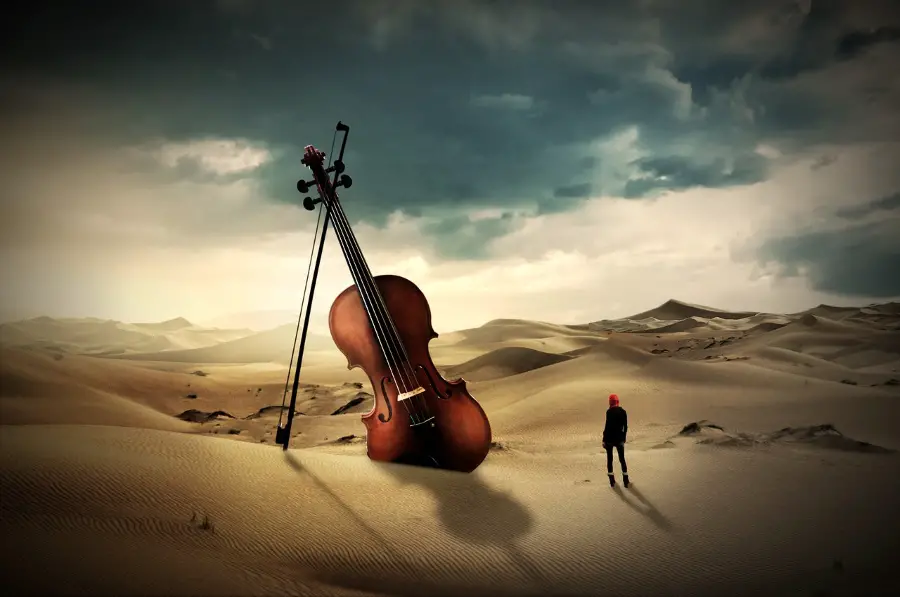
17 Parts of a Violin and Bow: A Compete Guide
The violin may seem like a simple instrument on the surface but is actually a very complex design made up of multiple components. Each component contributes to the sound and operation of the whole and the instrument wouldn’t be a the masterpiece which is the sum of all violin parts…and the bow to the top them all off!
For an instrument that is hundreds of years old, it’s a very complicated piece of engineering! That’s why we typically leave its repair to the professionals.
With that in mind, this article is going to break down every single element of a violin. The idea is to help your journey to mastery by providing a synopsis of every piece that makes up the instrument and what it does. Understanding your violin is all part of the process of mastering it!
You can see exactly each of the violin parts in the photo below, with each of them labelled accordingly.
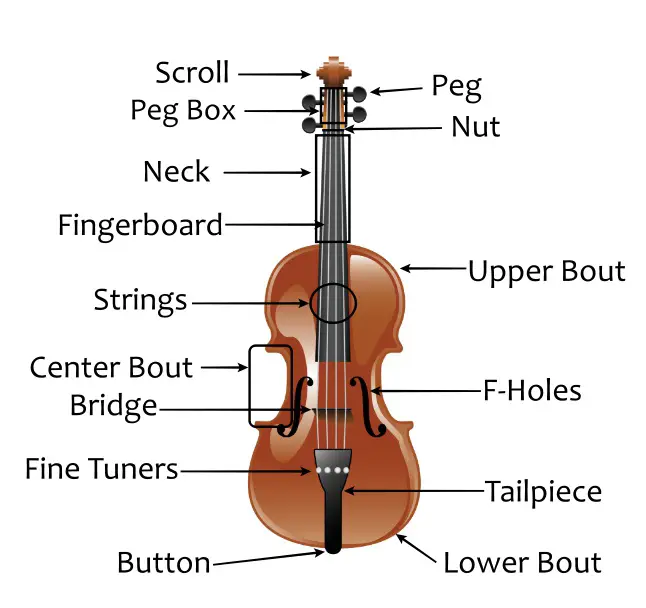
Source: Musilesson
Contents
Violin Parts List
- Scroll
- Tuning Pegs/Pegbox
- Nut
- Strings
- Neck
- Nose
- Fingerboard
- Body
- Perfling
- Back
- Sound Post
- Ribs
- F Holes
- Bridge
- Fine Tuners
- Tailpiece/Endpin
- Chin Rest
The violin bow is made up of:
- Hair
- Frog
- Screw
- Stick
- Pad
Let’s take a look at each of these components in a little more detail.
Parts of the Violin
Scroll
The scroll is at the very end of the violin above the tuning pegs.
It’s a decorative element that serves no musical function aside from adding a little elegance to the instrument. The scroll is usually the same shape and size but older violins can include much finer or more detailed scrolls.
Tuning Pegs and Pegbox
The tuning pegs stick out of the peg box and are used to maintain tune. There are four tuning pegs on a four string violin and five on a five string. They are wooden and fit into a hole on the pegbox. The pegs are wound until the violin string is in tune and can be tightened in position to maintain tune.
Read more: How to change violin strings
The pegbox is hollow and has threads that the tuning pegs screw into. The tuning pegs turn the string and often use friction to hold themselves into place. The tightness of the recess, the close fit of the tuning peg and the string combine to provide enough force to keep things in place.
This system is why a violin needs regular tuning. The system works but does allow the string to move slightly during use.
Nut
The nut is another small but important element of a violin.
It sits just below the peg box and above the fingerboard (the lower nut can be seen as the rectangular part just where the scroll end).
It is often made of ebony to be hard wearing and serves to keep the strings in position. There is a groove in the nut for each string to help hold them in place.
There are actually two nuts on a violin. The upper nut described above and the lower nut. The lower nut connects to the body of the violin beneath the bridge and also has grooves to hold the strings in place.
Strings
Violin strings are tuned G, D, A, E and are a pivotal part of how the instrument plays and how it sounds. They are typically made of a steel core surrounded by natural fibre, catgut, which isn’t actually cat’s guts, or synthetic fibre strings.
You can use the same set of strings for all notes or mix and match to suit your particular ear.
Many experienced violinists and most professionals will have a mixture of string types for each of the four violin strings. The ear over time will naturally find a tone it prefers and that won’t always be with the same pack or even type of string across each note.
Read More: How to Tune a Violin
Neck
The neck of the violin is behind (or under) the fingerboard and joins the tuning pegs, strings, fingerboard and scroll to the body. It is where the violinist will hold the instrument too so comfort is a key factor here.
There is a left handed neck and a right handed neck to make the instrument suitable for both kinds of musicians.
The violin neck is usually made of maple but can be made of other woods. It will have the same finish as the body and the fingerboard will be secured to the neck with adhesive.
Nose
The nose of a violin is the larger piece of wood that holds the neck onto the body. It is a structural element of the instrument and serves to ensure a solid connection between the body and neck and enough rigidity to both to help maintain tune.
Where you see the back of the neck roll down and thicken before it meets the body of the violin, that thicker piece of wood is the nose.
Fingerboard
The fingerboard is where the violinist places their fingers over the string in particular arrangements to create sound.
Often made of ebony because of its heard-wearing nature and contrasting colour to maple, it is a signature part of a violin and one that gets the most use.
You can tell an experienced violinist by their having black fingertips. This is taken from the ebony wood over time and practice. Fingerboards can be refinished where necessary to preserve their appearance but the finger staining is more difficult to remove.
Body
The violin body is the largest piece of the puzzle.
The body holds everything together but also creates the sound. The body of most violins will be made of maple but this can vary according to budget and manufacturer. The top body is made of a single piece of wood and holds the neck, bridge, F holes, tailpiece and chin rest. It is joined to the back body by the sound post.
There is a lot of precision required for building a violin body. The type of wood, the grain, the thickness and even the thickness of the varnish can all influence the depth of tone of the violin and has to be given very careful consideration. It’s an incredibly delicate operation to build a violin. This page over at Classic FM gives you an insight into just how delicate that process is.
Purfling
The violin purfling is another decorative element of the violin that serves no musical purpose. It’s the narrow wooden edging often made up of three strips of wood that run around the edge of the top and back of a violin. It is an aesthetic touch that serves to both make the violin look good and act as a signature of the maker.
There is a practical side to purfling too, in that it helps maintain cohesion of the wood of the body. It helps prevent cracks and splits in the wood that can occur during use and maintain the integrity of the wood during expansion and contraction due to climactic changes.
Back
The back of the violin is comprised of a single piece of maple in higher quality instruments or two pieces in lower priced violins. Single piece backs have a richer tone than two-piece backs but are more expensive. Like the violin body, the wood has to be carefully selected and prepared as the thickness, type and finishing will all contribute to the overall tone of the instrument.
The violin back will also have purfling but this is purely decorative. While it does help maintain structural integrity of the back, it doesn’t have to contend with the same level of pressure and use as the top.
Sound Post
The sound post acts as support for the two sides of the violin body and contributes to the overall sound of the violin. You will see the sound post underneath the bridge but it runs inside the violin and is secured to the opposite side of the body.
The sound post’s primary role is to add rigidity to the violin body but has a secondary role of influencing the tone of the sound it creates. For such a small and mostly invisible component, it punches way above its weight!
Ribs
The ribs of a violin are the curved sides of the violin that join the front and back of the body while maintaining the void in the centre. They begin life as 1mm thick piece of maple, or other woods and are heated or steamed until the wood is pliable enough to bend into shape. It’s a complex process that requires patience and skill to bend the wood into the desired shape while maintaining structural integrity.
Ribs are created using forms, templates of the designed shape of the ribs. The wood is steamed or otherwise heated and bent around the form. The wood is secured in place and allowed to dry. Once dry, the ribs are finished and added to the violin.
F Holes
The F holes are a signature element of a violin. They are the swirl cutouts on the top of the body that allows sound to escape and create the music. Violins without pickups depend on the F holes to create the desired sound. As part of your training, you will be taught to cant the violin towards the audience so the sound escapes the F hole giving the best sound to the listener.
The F hole allows air into the violin body to carry the tune. The specifically designed shape allows the air to carry particular frequencies at the lower end of the scale. There is apparently a lot of science behind this even though the F hole was part of the original violin design from the 17th century.
If you play a violin with pickups or an electric violin,if there is an F hole will be purely decorative.
Bridge
The bridge is another deceptively simple component of the violin. At first glance, it is just a piece of maple with four (or five) grooves cut into it to hold the strings in place. It stops the strings vibrating, allowing a consistent and predictable sound to emanate from each string when played.
The bridge also helps control vibration, resonance and the frequency of the strings, which is how you can play music at all. Combined with the tuning pegs and nuts, the bridge is the only part of the violin that touches the strings. Like the F hole, an incredible amount of thought has gone into the design, thickness, height, material and design of a violin bridge. Far more than an initial inspect might show!
This page on music acoustics from the University of New South Wales explains in detail how a bridge contributes to the overall sound of the violin.
Fine Tuners
Fine tuners are exactly what their name implies. Usually found at the base of the violin by the tailpiece, the fine tuner has an important role to play. The tuning pegs are very good at tuning but they don’t have the finesse for incremental adjustments. That’s where a fine tuner comes in.
Fine tuners can either be built into the violin or added to one. Some musicians prefer them to be added later so they can be customised and adjusted to their particular taste. They are made of metal and usually use a knob or screw to tune and hold that tune. Some musicians will only use a fine tuner on the E string and remove the others. Beginners will first use fine tuners on all strings and then remove them when they are ready.
It should be very obvious that a fine tuner is usually used while tuning your violin with a violin tuner.
Tailpiece/Endpin
The tailpiece is the element that holds the ends of the violin strings at the base of the violin by the chin rest. It is usually constructed of ebony or the same wood as used in the tuning pegs and chin rest for aesthetic reasons. Tailpieces can also be synthetic such as carbon fibre too.
The tailpiece anchors the strings to the lower bout of the body and is secured to the endpin using nylon monofilament. It fits into a tapered hole in the bottom of the violin to keep it in place. The endpin secures the tailpiece to the violin and ensures it remains rigid to keep the strings in tune.
Finally, if your violin has fine tuners, either on all strings or just on E, they will be affixes to the tailpiece on the strings so they can adjust the strings easily.
Chin Rest
The violin chin rest was not part of the original violin design but was added later to increase comfort during prolonged use. It is a supplemental element of the violin that can be fixed to the instrument or added later. The chin rest is a very personal choice and you will find yourself gravitating to a particular size or shape and sticking with it your entire musical career.
Chin rests are usually made of ebony or matching wood to the tailpiece but can also be made from any kind of wood or synthetic like carbon fibre.
Now that we’ve seen all the violin parts which make up the actual instrument, let’s take a look at what makes up the parts of a violin bow.
Parts of the violin bow
The violin bow is pivotal to how the violin sounds (you might want to check out its history). While the body and F holes are primary for creating that depth of sound and tone, a bow and the strings also contribute to the overall experience.
Hair
Many new violinists call this a bow string but is formally known as hair. It was originally made from horse hair and that is still often the case. There are also synthetic alternatives that can also deliver a rich sound.
The hair of a bow needs rosin to help maintain its condition and create the correct friction for sound. Rosin helps the bow hair deliver a consistent sound across the entire length of the bow and learning to add just enough rosin is part of the process of learning the violin.
Frog
The frog is the part of the violin bow the musician holds during use. It is made up of a larger piece of wood containing a screw adjuster or other adjustment to hold the hair in place. It may be decorative or plain and includes flat edges for comfort. The bow hair runs into a groove on the bottom edge of the frog to hold everything in place.
Screw
The bow screw is what keeps the hair tight. It is set into the end of the frog and connects to the bow to hold everything together. The screw can be completely removed to adjust or maintain the bow and frog and needs to be tightened to help the bow hair remain taught enough to play. It’s a simple design that is very effective in use.
Stick
The bow stick, while an inelegant name, is the main element of a violin bow. It’s the single piece of wood that supports the hair and the frog. A bow should be strong, yet supple, attractive, yet simple and be comfortable to use for many hours at a time.
A bow stick also has good balance to help with the smooth movement of the hair over the violin strings. Like many aspects of play, you will naturally gravitate to one particular bow and stick with it throughout your career.
Pad
The bow pad is a thin piece of leather or synthetic material that protects the bow stick and adds an element of comfort and grip for the musician. It’s a tiny but very important part of the violin as it provides the confident grip on the bow you need to play with ease.
Summing up the violin
As you can see, there is a lot more to the violin than initially meets the eye. Don’t let it’s complexity put you off though. Like most things to do with music, you can begin with the basics and learn your trade gradually over time. The more you understand the violin parts, the better you’ll be able play it.
If you’re new to the violin and would like suggestions on some top quality beginner and intermediate violins without breaking the bank, we can help!
- Viola vs Violin – 5 Key Differences Between The Two Instruments - March 20, 2024
- 15 of the Most Famous Violinists of All Time (18th Century to Present) - March 20, 2024
- Full School Band Instruments List (Elementary / Middle / High) - March 18, 2024


